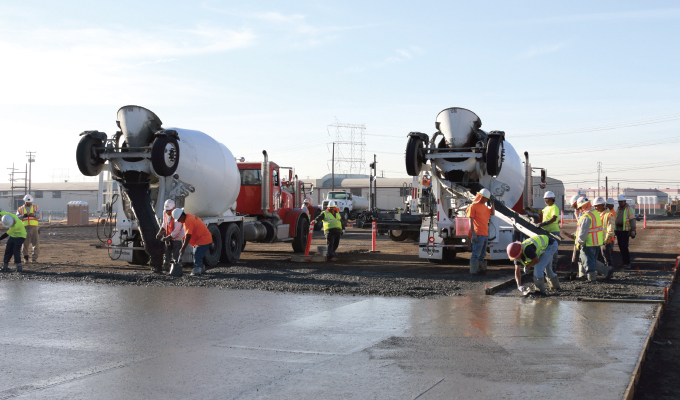Offering crack resistance from plastic and drying shrinkage, fiber-reinforced concrete is an increasingly popular choice for flatwork and elevated construction—from precast and ready-mix concrete to shotcrete. Some fiber types even greatly reduce construction time and eliminate the need for steel.
WHY USE FIBERS?
Regarded as a cost-effective, durable, and even sustainable alternative to conventional steel, fiber-reinforced concrete boasts a variety of benefits:
- Prevents plastic and drying shrinkage cracks
- Enables faster construction times and lower labor costs
- Finishes smoothly with any surface fibers quickly fading under foot/vehicle traffic
- Provides same level of reinforcement as wire mesh with even distribution
- Eliminates need for chairs to support conventional rebar and wire mesh
- Well recognized by major concrete organizations and tested to industry standards
HOW SYNTHETIC FIBERS COMPARE TO STEEL
Micro-synthetic fibers provide superior resistance to plastic shrinkage cracking over welded wire, but aren’t resistant to additional cracking from drying shrinkage, structural load, or other forms of stress. However, they should be regularly specified in any concrete type to improve cracking resistance, spall protection, freeze-thaw durability, and homogeneity of concrete during placement. Microfibers are available in ½-inch – ¾-inch (12 – 19 mm) lengths, with dosage rates varying from 0.5 – 1.5 lbs/yd3 (0.3 – 0.9 kg/m3) depending on fiber product and application type.
Macro-synthetic fibers not only provide resistance to plastic shrinkage but enhance concrete’s durability and limited structural capacity when properly designed and distributed three dimensionally.
Macrofibers are like steel fibers, but typically easier to place and finish due to their lighter weight, non-corrosive nature and high pumpability. They are available in 1 ½-inches – 2-inches (38 – 50 mm) lengths, with dosage rates varying from 3.0 – 15 lbs/yd3 (1.8 – 9.0 kg/m3) depending on fiber product and application type.
So, can synthetic fibers compete “head-to-head” with steel? Absolutely! Macrofibers offer durability and residual strength capacity equivalent to steel. Macrofibers generally require 5-10 times less material weight than steel, streamlining on-site handling and storage. Their non-magnetic and non-corrosive characteristics also make them ideal for exterior pavements where aesthetics and safety are a concern. Additionally, these fibers are more pliable and less abrasive to pumping lines and equipment.

CONCRETE FLOORING
Fiber reinforcement can be used to replace steel for temperature/shrinkage crack control and limited structural applications in concrete floors. The 3D design offers greater abrasion, fatigue, and impact resistance while increasing service life and durability.
The concrete matrix’s increased tensile capacity also reduces shrinkage stresses, which allows for increased control joint spacing with macrofibers. This is combined with improved concrete mix designs using advanced chemical admixtures and proper placement/curing practices.
Some fiber manufacturers have experimented with joint-free floors. Low water-to-cement ratio, less cement content, and shrinkage reducing and/or compensating admixtures with adequate curing reduces the risk for curling and shrinkage cracks. Factors like proper subgrade preparation, placement, saw-cut depth, curing time and exposure conditions must also be considered.
It is highly recommended to conduct testing and verification prior to flooring construction to meet engineering and specification requirements. This typically involves initial shrinkage tests on the proposed concrete mix design to establish general shrinkage characteristics, which then informs potential joint spacing measurements.
CONCRETE PAVEMENT
Fiber-reinforced concrete is a cost-effective, sustainable solution for resurfacing and rehabilitating existing pavements and bridge decks. Many state DOTs and other transportation agencies are recommending macrofibers and developing performance-based specifications for overlays and full-depth replacement systems for a long, maintenance-free service life. Macrofibers also significantly reduce installation time and labor, while producing concrete pavements that are easily placed with less environmental impact on the jobsite.
CONCRETE WALL SYSTEMS
Macro-synthetic fibers are also used as an alternative to steel reinforcement for concrete wall systems. The dosage rates are based on strength-to-strength calculations supported by standardized test methods and industry practices. This significantly reduces time and labor costs, while producing more durable concrete. Macrofibers can also provide the same strength capacity as steel in wall applications like foundations and retaining walls.
Macrofibers are a cost-effective, sustainable solution for buildings constructed with insulated concrete form (ICF) wall systems, which have historically been reinforced by steel rebar engineered to resist forces from soil, wind and other loading conditions. Dosed correctly, macrofibers eliminate rebar in ICF wall systems.
CONSIDERATIONS FOR CONCRETE MIX DESIGN & APPLICATION
Adding fibers often reduces the slump of a concrete mix, which measures the workability of fresh concrete during placement. This is like adding more ingredients to the mix and, therefore, requires more fluid to maintain an apparent slump. Used at typical dosages, microfibers only decrease slump slightly and don’t require major changes to maintain placement characteristics. Yet, macro-synthetic and steel fibers can significantly impact concrete workability, depending on fiber type and dosage.
The ACI 544.3 standard offers recommendations that can modify the mix design of fiber-reinforced concrete. The use of chemical admixtures like superplasticizers or water reducers can also increase concrete workability without adding water.
SURFACE FINISHING
Factors such as fiber material type, architecture, dimension, and dosage may affect the surface finish of fiber-reinforced concrete, as well as the required surface-finishing method. Stiff or rigid fibers typically have a greater tendency to protrude up through the slab than flexible fibers.
Proper external vibration is another key factor when finishing fiber-reinforced concrete. Generally, the same finishing techniques and approximate timing as conventional concrete should be used. When casting samples for testing, no internal vibration within the molds can be used.Synthetic fibers may delay bleed water at the surface, which impacts finish timing on larger slabs.
Brooming in one direction or using specific broom bristles to align surface fibers can minimize surface appearance. If necessary, a torch can burn off synthetic fibers on a concrete surface once all desired properties are achieved. When finishing industrial, commercial and warehouse floors where high dosage levels of macro-synthetic and steel fibers are used, a laser or vibrating screed is usually recommended.
CLOSING THOUGHT
In conclusion, fiber-reinforced concrete provides a resilient, durable and cost-effective construction solution while also providing safer working conditions and more efficient construction.

About the Author:
Michael Mahoney is a professional engineer and director of marketing and technology for fiber-reinforced concrete at Euclid Chemical. He is a fellow and member of the American Concrete Institute and has served on various committees for the National Pre-Cast Concrete Association and American Society for Testing and Materials. For more, visit www.euclidchemical.com.
Modern Contractor Solutions, September 2023
Did you enjoy this article?
Subscribe to the FREE Digital Edition of Modern Contractor Solutions magazine.



